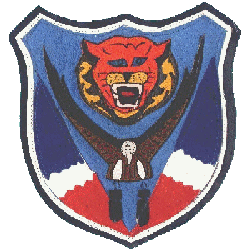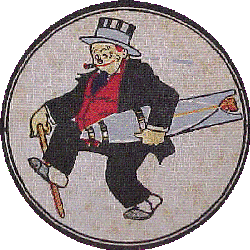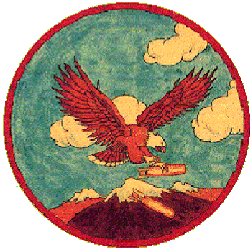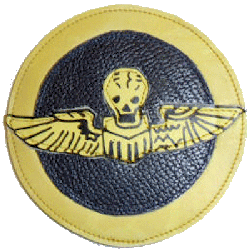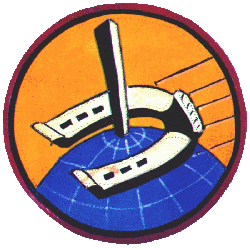The following words are the opening for the 491st Bombardment Squadron's Monthly History Report, July 1945. At the time the 341st Group, along with its 11th, 22nd and 491st Squadrons, was stationed at Yang Chiseh Airfield, Yangkai in southwestern China about 45 miles northeast of Kunming. The Group's fourth Squadron, the 490th, had transferred in April, from attachment to the Tenth Air Force in Burma and was now stationed at Hangchung in northern China.
"It was a leaden Sunday afternoon and ideal for the GIs
and the officers of the 341st Bomb Group to get in some
precious time on the sack. And they were fulfilling this
mission to the best of their ability. All the barracks on
the base were quiet, save for an occasional snore and the
faint patter of rain on the tarpapered roofs. The
beautiful valley of Yangkai was draped in slumber and at
a time like this not even a proclamation of V-J Day would
have had any effect on the Sabbath-loving soldier. Or so
it seemed. Then suddenly it happened. Men began to run
out of the barracks like frightened hares, hurriedly
tossing on some essential bits of clothing as they ran.
Those who had been rudely awakened from the arms of
Morpheus or Hedy Lamarr jumped with fright out of their
beds. Surely, they thought, it must be a 'Jing Bao' -- a
three-ball without warning. Jeeps began to pound the
bumpy dirt roads and oddly enough they were all headed in
the same direction; the airfield. Then it was not an air
raid, evidently; what was it then that had the power to
move the immovable GI out of his sack at the ungodly hour
of 3 in the afternoon?
"From the distance came the muffled roar of approaching
aircraft. The sound became louder in swift crescendo, and
low! In the thin soup overhead there appeared three
formations of a type of aircraft never before seen in the
China Theater. Nine A-26s, circling and peeling off to
land, had arrived in China after their crews had
completed a rigorous six-week training period at Fenni,
India. More graceful and compact than the now discarded
Mitchell, the Invaders barreled down in rapid succession
to nine perfect landings. This was an event worth seeing.
The old order was changing before the eyes of the hardy
ones who braved the cold chilling rain and persistent
mosquitoes -- the bomb group which had made history with
the now almost obsolete B-25 was having its face lifted.
It was a time for rejoicing and also for a little
sadness, for the Mitchell was a "ding hao" ship and a
true friend to all the men who knew her well. It was a
time for gladness, because the A-26 symbolized a new
phase in the war against the only remaining enemy, the
phase that would spell defeat for the tailspinning
Japanese.
"So Sunday, 29 July 1945, marked the beginning of a new
era for the oldest medium bomber group in the China
Theater. The China Glippers looked forward to new
horizons, new skies to conquer. And, by the sound of
clanging hammers, the smell of wet paint, and the airing
of musty barracks bags on the base, it appeared that the
Group was going to get its wish. - and soon."
The Group would create very little history in the few remaining days of the worst war the world had ever known. But, they didn't need to! Almost everything the members of the Group had done since its inception was historical, beginning with the 11th Bomb Squadron being the first US Army Air Force unit to combat the Japanese in China, already invaded by the enemy and whose very existence was continually threatened.
On September 15, 1942, the 341st Bombardment Group (M), AAF, was activated at Camp Malir, Karachi, India, in accordance with letter A.G. 320.2, date 7/21/42 Mr-M-AF, and with paragraphs II, III, & IV, General Order #22, HQ, 10th United States Air Force, dated September 3, 1942. Lieutenant Colonel Torgils G. 'Torgi' Wold assumed command.
Col. Wold arrived at Karachi several months earlier as a pilot in Force Aquilla, a secret plan for early bombardment of Japan by bombers flying from bases in eastern China. Commanded by Colonel Caleb V. Haynes, planning and preparation for the project was occurring in the U.S.A. simultaneously with the 'Doolittle Raid' project. However, when the Aquilla aircraft arrived in India, in mid-April, the East China bases from which the attacks were to launch had been captured by the Japanese. The project was cancelled, and the men and aircraft of Project Aquilla were absorbed by the 10th Air Force.
In preparing for the 341st Bomb Group's activation, Wold was assisted by Lt. Col. Clinton D. 'Casey' Vincent, who later served as Chennault's Operations Officer, then was promoted to Colonel and became Commander of the East China Command and, as one of the youngest Brigadier Generals ever, Commander of the 68th Composite Wing. During this time, 'Casey' was to become the inspiration for "Vince Casey" in Milt Caniff's "Terry & the Pirates" comic strip.
The headquarters cadre of the 341st, comprising two officers, 1Lt R. O. Nelson (S-1) and 1Lt R. F. Gallaway (S-4) and nine enlisted men were assigned from HQ and HQ Squadron, 7th Bomb Group (H). The 11th and 22nd Bomb Squadrons (M) were removed from attachment to the 7th and assigned to the 341st intact. Cadres of twenty-nine enlisted men, each, were assigned from these Squadrons to the newly activated 490th and 491st Bomb Squadrons (M). The 11th furnished the cadre for the 490th and the 22nd furnished the cadre for the 491st.
Maj. William E. Bayse was transferred from the 7th Bm Grp, and remained in command of the 11th Bm Sq Air Echelon already stationed at Kunming, China. Maj. Frank D. Sharp was transferred from the 7th Bm Grp at Allahabad, India, and assumed command of the 22nd Bm Sq, and Capt. Blair M. Sorenson arrived from the 11th at Kunming to assume command of the 491st Bm Sq. The support personnel of the 11th, the entire 22nd and the cadres of the 490th and 491st were quartered in areas "A" and "B" at Malir. All units at Malir moved to area "H" on September 28th.
This web site is provided as a public service. It is intended to provide factual, historical information to the public, to commemorate preserve memory of the sacrifices of our World War II veterans serving with U.S. Army Air Forces in the China-Burma-India theater. Permission is required for any commercial use or mass distribution purposes of the copyrighted material.
